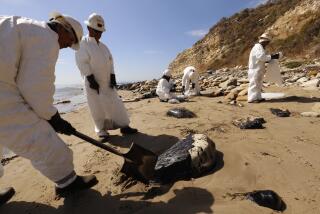Keystone oil pipeline shut down after a rupture in rural North Dakota
- Share via
BISMARCK, N.D. — The Keystone oil pipeline was shut down Tuesday morning after it ruptured in North Dakota, with the spill confined to an agricultural field.
The cause of the rupture and the volume of crude oil spilled were not immediately clear. An employee working at the site near Fort Ransom heard a “mechanical bang” and shut down the pipeline within about two minutes, said Bill Suess, spill investigation program manager with the North Dakota Department of Environmental Quality.
Oil was reported surfacing 300 yards south of the pump station in a field and emergency personnel responded, Suess said.
No people or structures were affected by the spill, he said. A nearby stream that only flows during part of the year was not impacted but was blocked off and isolated as a precaution, he said.
It’s unclear at what rate the 30-inch pipeline was flowing, but even at two minutes “it’s going to have a fairly good volume,” Suess said. “But ... we’ve had much, much bigger spills,” including one involving the same pipeline a few years ago in Walsh County, N.D., he said.
“I don’t think it’s going to be that huge,” Suess said.
The $5.2-billion pipeline constructed in 2011 carries crude oil across Saskatchewan and Manitoba through North Dakota, South Dakota, Nebraska, Kansas and Missouri to refineries in Illinois and Oklahoma. Though the pipeline was constructed by TC Energy, it is now managed by liquid pipelines business South Bow as of 2024.
The Associated Press has reached out to South Bow for comment.
A proposed extension to the pipeline called Keystone XL would have transported crude oil to refineries on the Gulf Coast, but it was ultimately abandoned by the company in 2021 after years of protests from environmental activists and Indigenous communities over environmental concerns.
Dura and Raza write for the Associated Press.
More to Read
Sign up for Essential California
The most important California stories and recommendations in your inbox every morning.
You may occasionally receive promotional content from the Los Angeles Times.









